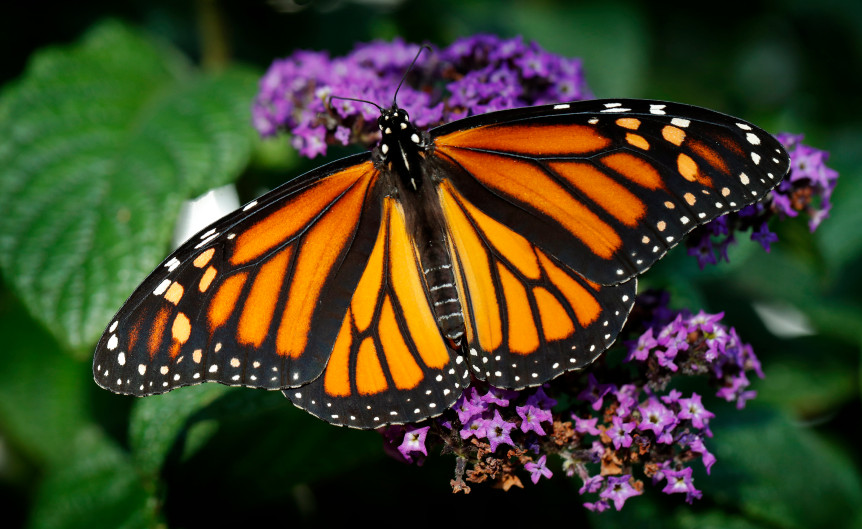Neighborhood Butterfly Guide
Brought to you by Doug Tabony
In the fall of 2016 the birds that would come every day to our feeders seem to just disappear, but suddenly there were many more species of butterflies than usual.
My wife, Jo, took the photos of the Lavinia skipper and the photo of the Hackberry Emperor, wings closed. The rest were taken from numerous sources on the Internet.
 |
 |
| American lady Wing span: 1 1/4 – 1 1/2" Life History: During the afternoon, males perch on hilltops or on low vegetation if there are no hills. Females lay eggs singly on the top of host plant leaves. Caterpillars are solitary, living and feeding in a nest of leaves tied with silk. Adults hibernate. http://www.butterfliesandmoths.org/species/vanessa-virginiensis | |
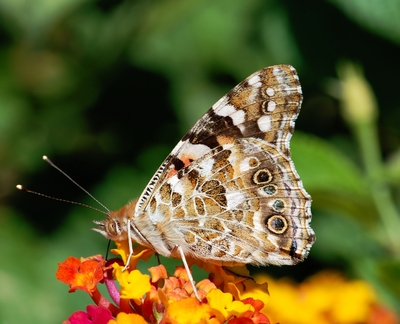 |
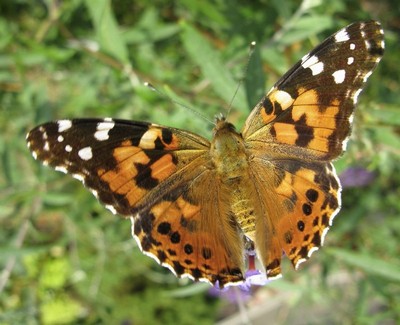 |
| Painted lady Wing span: 2 – 2 7/8" Life History: Males perch and patrol during the afternoon for receptive females. In the West males usually perch on shrubs on hilltops, while in the East males perch on bare ground in open areas. Females lay eggs singly on the tops of host plant leaves. Caterpillars live in silk nests and eat leaves. Adults hibernate only in the South and in mild winters. http://www.butterfliesandmoths.org/species/Vanessa-cardui | |
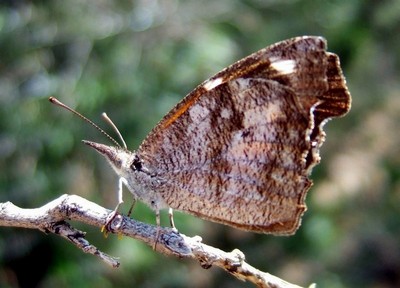 |
 |
| American snout Wing span: 1 3/8 – 2" Life History: Adults perch on branches and imitate dead leaves by holding palps and antennae downward to look like petioles. Males patrol near host plants to seek females. Eggs are laid in small groups on leaves of the host tree; caterpillars eat young leaves. Adults overwinter in the southern part of their range. http://www.butterfliesandmoths.org/species/Libytheana-carinenta | |
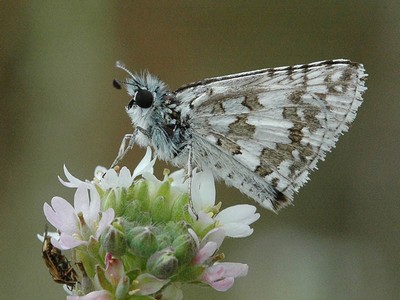 |
 |
| Common checkered skipper Wing span: 1 – 1 1/2" Life History: Males patrol in swales most actively in the afternoon, and mating takes place then. Females lay eggs singly on leaf buds and tops of leaves. Adults roost exposed on a tall plant beginning in late afternoon. Caterpillars make folded-leaf nests in which they live and feed, and fully-grown caterpillars hibernate. http://www.butterfliesandmoths.org/species/Pyrgus-communis | |
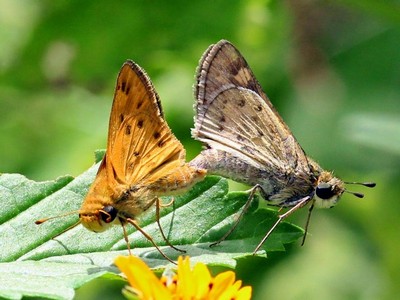 |
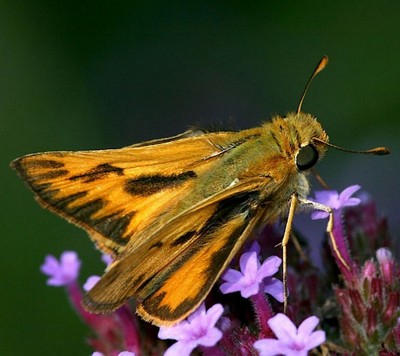 |
| Fiery skipper Wing span: 1 1/4 – 1 1/2" Life History: Males perch in lawns and grassy swales to wait for receptive females. Eggs are laid singly under leaves and also on other plants and objects. Caterpillars eat leaves and roll and tie them to make shelters which lie horizontally in the sod. http://www.butterfliesandmoths.org/species/Hylephila-phyleus | |
 |
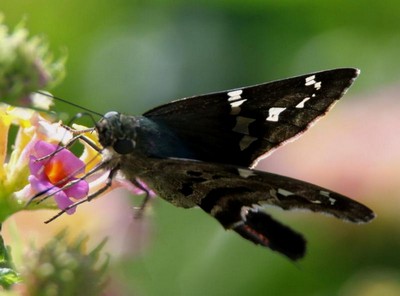 |
| White-striped longtail skipper Wing span: 1 1/2 – 2 1/8" Life History: The White-striped Longtail has a fast and erratic flight, and perches on the upper sides of leaves. http://www.butterfliesandmoths.org/species/Chioides-albofasciatus | |
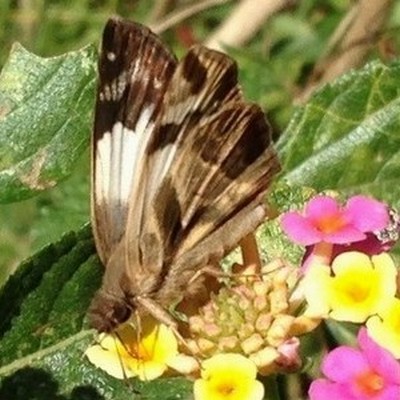 |
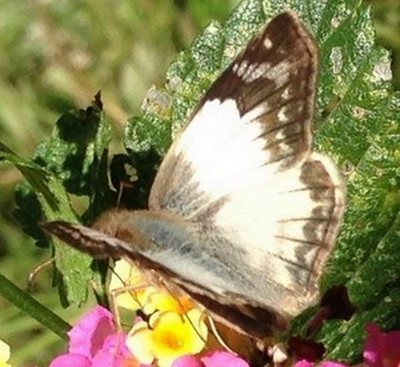 |
| Lavinia (Turk’s cap) white skipper Wing span: 1 1/4 – 1 3/8" Life History: Females lay eggs on twigs and buds of the host plant. Caterpillars feed on young leaves, flowers, and fruits. Young caterpillars hide in cracks on the host plant, while older ones live in shelters made of leaves. http://www.butterfliesandmoths.org/species/Heliopetes-macaira | |
 |
 |
| Bordered patch Wing span: 1 3/8 – 2" Life History: During the day, males patrol around host plants or patrol and perch on hillsides in search of fem ales. Eggs are laid in large groups on the underside of host plant leaves. Young caterpillars are gregarious and eat the underside of leaves; older caterpillars are solitary and eat leaves and stems. Third-stage caterpillars hibernate, and they may also go into diapause during the summer. http://www.butterfliesandmoths.org/species/Chlosyne-lacinia | |
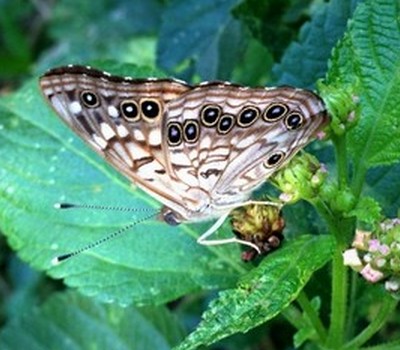 |
|
| Hackberry emperor Wing Span: 1 3/8 - 2 1/2" Life History: Hackberry Butterflies fly in a fast and erratic manner, and rest upside down on tree trunks. Males perch on tall objects in sunny areas to watch for females. Eggs are laid in clusters, and the young caterpillars feed communally. Caterpillars overwinter in groups gathered inside dead rolled leaves. https://www.butterfliesandmoths.org/species/Asterocampa-celtis | |
 |
 |
| Cloudless sulfur Wing span: 2 1/4 – 3 1/8" Life History: Males patrol with rapid flight, searching for receptive females. Eggs are laid singly on young leaves or flower buds of host plants; caterpillars eat leaves and rest on underside of leaf petioles. http://www.butterfliesandmoths.org/species/Phoebis-sennae | |
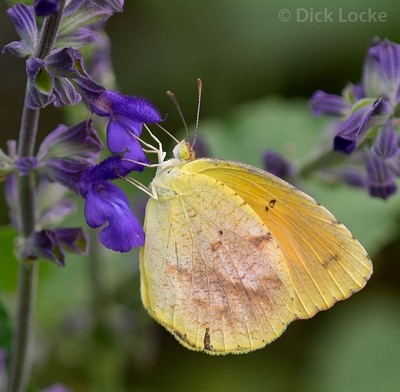 |
 |
| Sleepy orange sulfur Wing span: 1 3/8 – 2 1/4" Life History: Males patrol flats and gullies for females. Females lay eggs singly under host plant leaves. Caterpillars eat leaves. Dry season form overwinters and lays eggs in spring. http://www.butterfliesandmoths.org/species/Abaeis-nicippe | |
| Southern dogface Wing Span: 2 1/8 - 3" Life History: Males patrol open areas for females. Eggs are laid on the undersides of terminal leaves of host plants. Adults overwinter in reproductive arrest. https://www.butterfliesandmoths.org/species/Zerene-cesonia | |
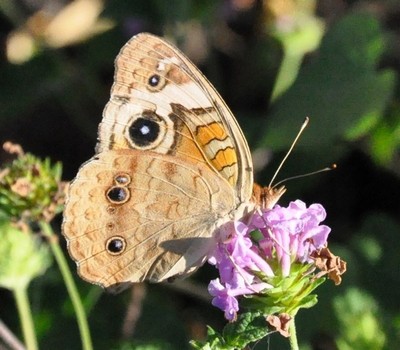 |
 |
| Common buckeye Wing span: 1 5/8 – 2 3/4" Life History: Males perch during the day on low plants or bare ground to watch for females, flying periodically to patrol or to chase other flying insects. Females lay eggs singly on leaf buds or on upperside of host plant leaves. Caterpillars are solitary and eat leaves. Caterpillars and adults overwinter but only in the south. http://www.butterfliesandmoths.org/species/Junonia-coenia | |
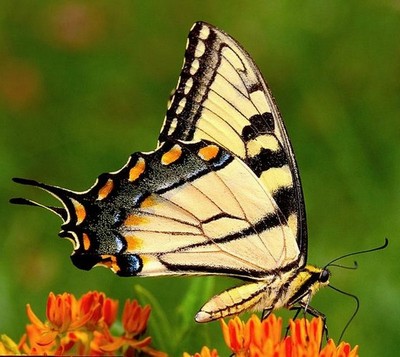 |
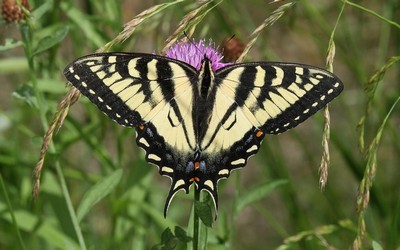 |
| Tiger swallowtail Wing span: 2 1/2 – 4 1/2" Life History: Two broods in the north, three in the south. Males patrol for receptive females. Females lay eggs singly on host leaves. Caterpillars eat leaves and rest on silken mats on the upper surface of leaves. Chrysalids overwinter. http://www.butterfliesandmoths.org/species/Papilio-glaucus | |
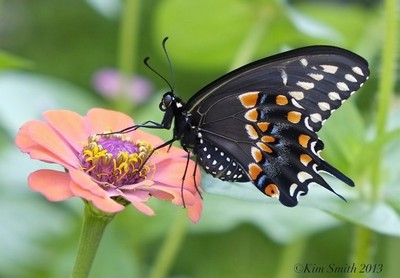 |
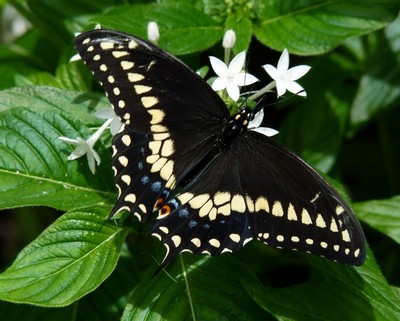 |
| Black swallowtail Wing span: 3 1/4 – 4 1/4" Life History: Males perch and patrol for receptive females. Female lays eggs singly on leaves and flowers of the host, which are then eaten by hatching larvae. Hibernates as a chrysalis. http://www.butterfliesandmoths.org/species/Papilio-polyxenes | |
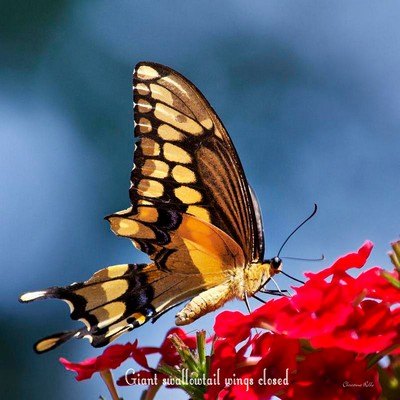 |
 |
| Giant swallowtail Wing span: 4 – 6 1/4" Life History: Males patrol for receptive females. Females lay single eggs on host leaves and twigs. Caterpillars resemble bird droppings and eat leaves and young shoots. Chrysalids hibernate. http://www.butterfliesandmoths.org/species/Papilio-cresphontes | |
 |
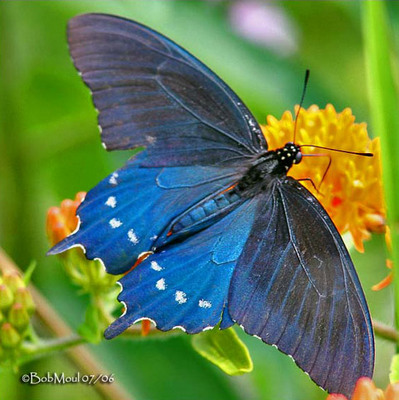 |
| Pipevine swallowtail Wing span: 2 – 3/4" Life History: Adult males patrol likely habitat in search of receptive females. Females lay batches of eggs on underside of host plant leaves. Caterpillars feed in small groups when young but become solitary when older. Wintering is by the chrysalis. http://www.butterfliesandmoths.org/species/Battus-philenor | |
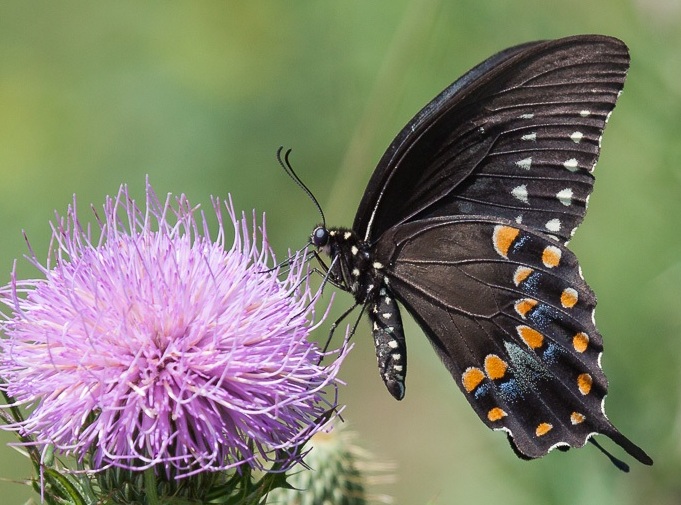 |
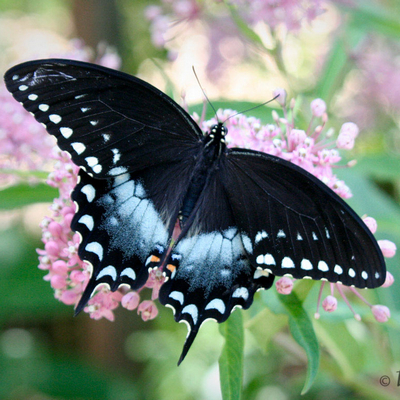 |
| Spicebush swallowtail Wing Span: 3 – 4' Life History: Males patrol in woods, roads and woodland edges to find receptive females. Females lay single eggs on underside of host plant leaves. Caterpillars live in shelters of folded-over leaves and come out to feed at night.Some chrysalids from each generation hibernate. https://www.butterfliesandmoths.org/species/Papilio-troilus | |
 |
 |
| Zebra longwing Wing span: 2 3/4 – 4" Life History: Males patrol for females, and are also attracted to female chrysalids. A male will wait on the chrysalis and mate with the female as she is about to emerge. He then deposits on her abdomen a chemical than repels other males. Eggs are laid in groups of 5-15 on leaf buds or leaves of the host plant; caterpillars feed at night on leaves. Adults roost communally in groups of 25-30 individuals. http://www.butterfliesandmoths.org/species/Heliconius-charithonia | |
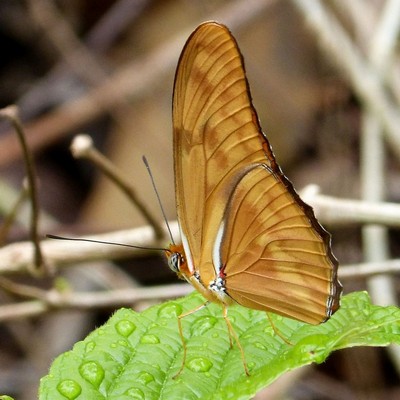 |
 |
| Julia longwing Wing span: 3 1/4 – 3 5/8" Life History: Males patrol all day for receptive females. Eggs are laid singly on new growth; caterpillars feed on leaves. Adults forage along a set route of nectar sources each day in a behavior known as "trap-lining". http://www.butterfliesandmoths.org/species/Dryas-iulia | |
 |
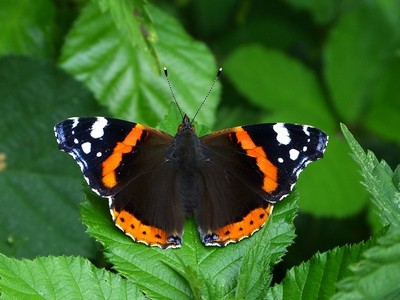 |
| Red admiral Wing span: 1 3/4 – 3" Life History: The Red Admiral has a very erratic, rapid flight. Males perch, on ridgetops if available, in the afternoon to wait for females, who lay eggs singly on the tops of host plant leaves. Young caterpillars eat and live within a shelter of folded leaves; older caterpillars make a nest of leaves tied together with silk. Adults hibernate.http://www.butterfliesandmoths.org/species/vanessa-atalanta | |
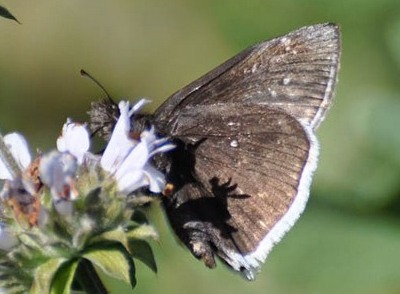 |
 |
| Funereal duskywing Wing span: 1 5/16 – 1 3/4" Life History: Eggs are laid singly under host plant leaves. Caterpillars feed on leaves and rest in shelters of rolled or tied leaves. Caterpillars from the last brood hibernate. http://www.butterfliesandmoths.org/species/Erynnis-funeralis | |
 |
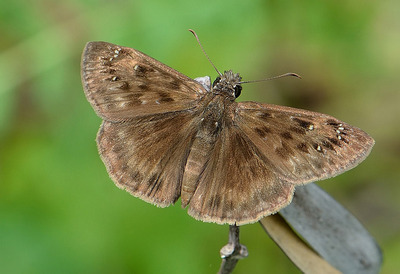 |
| Horace’s duskywing Wing Span: 1 7/16 - 1 15/16" Life History: To seek females, males perch at the ends of twigs on hilltops or slopes about 1 foot above the ground. Mating has been observed around midday; females deposit eggs singly on new growth of the host. Caterpillars feed on young leaves and rest in leaf nests. Caterpillars of the last brood hibernate. https://www.butterfliesandmoths.org/species/Erynnis-horatius | |
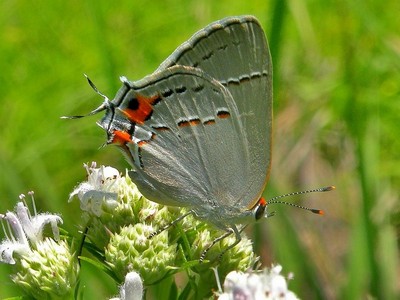 |
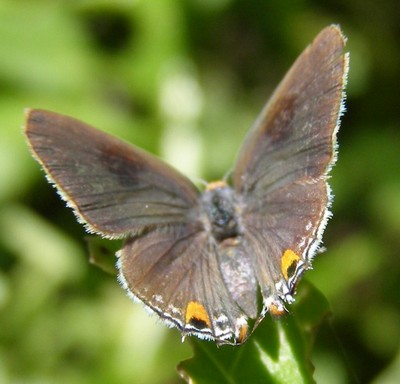 |
| Gray hairstreak Wing span: 7/8 – 1 3/8" Life History: Eggs are laid singly under host plant leaves. Caterpillars feed on leaves and rest in shelters of rolled or tied leaves. Caterpillars from the last brood hibernate. http://www.butterfliesandmoths.org/species/Strymon-melinus | |
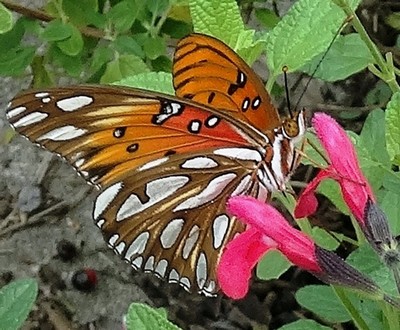 |
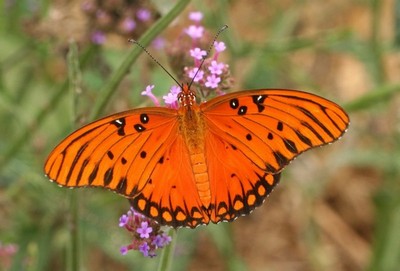 |
| Gulf fritillary Wing span: 2 1/2 – 3 3/4" Life History: Males patrol for females, who lay eggs on many parts of the host plant. Caterpillars feed on most parts of the host. Adults overwinter in the south. http://www.butterfliesandmoths.org/species/Agraulis-vanillae | |
 |
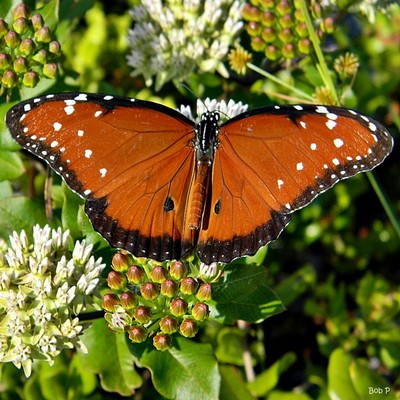 |
| Queen Wing span: 2 5/8 – 3 7/8" Life History: To find females, males patrol all day. Females lay eggs singly on leaves, stems, and flower buds; which the caterpillars eat. Adults roost communally. http://www.butterfliesandmoths.org/species/Danaus-gilippus | |
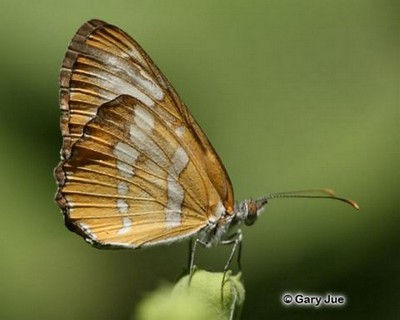 |
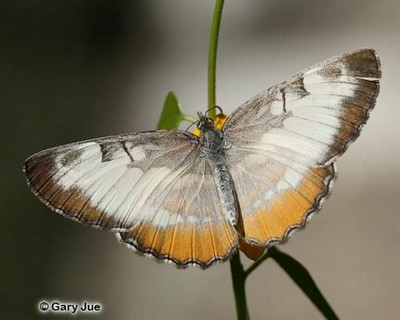 |
| Common mestra Wing span: 1 3/8-1 15/16" Life History: Adults fly slowly and stay near the hostplants. http://www.butterfliesandmoths.org/species/Mestra-amymone | |
 |
|
| Monarch Wing span: 3 3/8 – 4 7/8" Life History: Adults warm up by basking dorsally (with their wings open and toward the sun). Females lay eggs singly under the host leaves; caterpillars eat leaves and flowers. Adults make massive migrations from August-October, flying thousands of miles south to hibernate along the California coast and in central Mexico. A few overwinter along the Gulf coast or south Atlantic coast. Along the way, Monarchs stop to feed on flower nectar and to roost together at night. At the Mexico wintering sites, butterflies roost in trees and form huge aggregations that may have millions of individuals.During the winter the butterflies may take moisture and flower nectar during warm days. Most have mated before they leave for the north in the spring, and females lay eggs along the way. Residents of tropical areas do not migrate but appear to make altitude changes during the dry season. http://www.butterfliesandmoths.org/species/Danaus-plexippus | |
